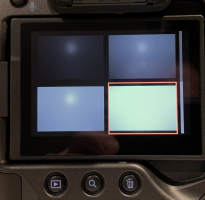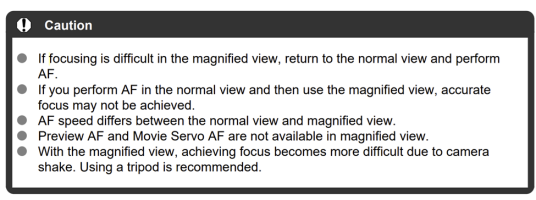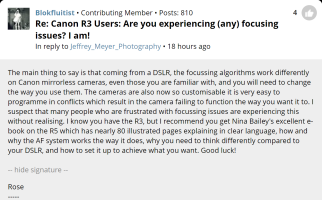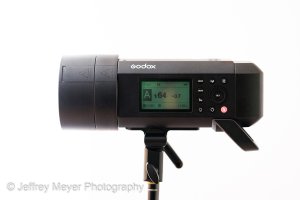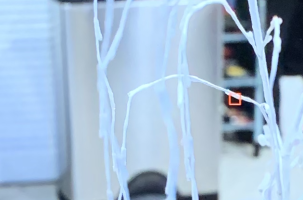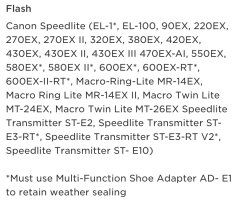Hi everyone. I recently purchased a Canon R3, and jumped into the mirrorless world with two feet and an open mind. My former camera was a Canon 1Dx, and it's still going strong — after 10-years of use — with great results and awesome reliability. Sadly, however, my newly purchased Canon R3 is causing me some major heart palpitations and confidence worries, and I'm hoping (praying) that my experiences are related to my not yet knowing much about the R3's mirrorless settings or its operation. Yet, I suspect something more technical beyond my settings may be at hand, so thus my outreach.
Question for R3 users, are you experiencing (any) major focusing issues?
I'm experiencing at least five (5) unique issues:
For example:
1) When using "single point", "one shot" focus on a stationary subject (very basic stuff), my camera will (sometimes) not focus at all. It's almost like it locks up (i.e., it won't even hunt), but I can sense that it's trying to work (i.e., the focus box will light up red), but it just doesn't work. All I see is a blurry screen. Shutter button will not work. Then, as-if almost randomly and without my understanding, it will suddenly focus and the shot will be captured. I've tried changing various settings like my "shutter mode" from "electronic" to "mechanical" to see if that might be something behind it, but I'm getting the issue it in both cases. Again, I'm completely new to mirrorless technology, so perhaps it's a setting/mode function restriction I don't yet know about? When I handed the camera to my wife, she experienced the same thing.
2) When focusing on nearby subjects (but still respecting the minimum focusing distances of my lenses) my camera will again (sometimes) not focus on the subject, but this time, however, it will at least continuously "hunt" back-and-forth trying to focus, and the shutter will depress and capture a blurry image. Yet, in such cases it will often never achieve the focus. So, I power off my camera, and restart. That unacceptable solution has sometimes worked out, but clearly that's not a tenable response. I've experienced this with my Canon EF 100mm f/2.8L lens (using the RF attachment ring) and the only RF lens I also recently purchased (the 50mm f/1.2L).
3) When more than one subject is in the scene, and layered, my camera really (noticeably) struggles to focus on a foreground subject, but is perfectly ok with focusing on the background (or distant) subject. This experience is really annoying, and it's seriously eroding my confidence in using this camera. I often cannot get it to focus on the foreground subject despite moving my focusing point over the foreground object. On a combination of issues 2 and 3, I randomly noticed that Tony & Chelsea Northrup were also observing some of this, but they observed these things using other R3 settings and other subject dynamics I have yet to try. You can see their review here. At different points in their review, you can hear them clearly say that they were: “missing focus on a lot of the closer shots”; “Tracking focus is exponentially harder the closer the subject gets to the camera”; "At close range, the autofocus wandered a lot even when it was locked on […] it just hunted in and out”. In my experience, I would most certainly agree, but my issues appear worse because (sometimes) I literally couldn't shoot the image despite pushing the shutter button.
4) Sometimes, my focusing point will not move, despite my trying to reposition it. It just sits wherever it may be on the screen. Again, almost as-if it locks up.
5) When focusing with "eye control", which does somewhat work for me, I cannot get the camera to focus on the left side of the screen with my eye, despite several calibration attempts under different lighting conditions. It will only work top, bottom, and right. A second issue is that the focus won't "stay" where my eye is looking. Obviously, hard to explain in a forum, but while I'm clearly looking at a fixed point (almost stubbornly with intense concentration) I can notice the focusing box awkwardly drifting in a slow straight line to the right of the screen. Almost like a mouse button randomly locking up on you and it drifting off in a straight line to the corner of a monitor.
Final points: While my time and experience in using the Canon R3 is limited, I have had some wonderful experiences too. Like when I was able to photograph my newborn son sleeping without disturbing him. I was able to accomplish this by using the "silent shutter" mode and the tilt screen angled high above my head with subject tracking on in a very low ambient light situation under high ISO values. That whole situation and combination of features just worked out awesomely in a way my 1Dx never could, and it was honestly borderline ridiculous how my low light shot held from a distance above my head turned out tack sharp with no discernable noise. But clearly the other focusing problems I'm having are a no-go.
Altogether, I really, really want this to work out, and give the future of mirrorless cameras a chance. Yet, I must confess, a large part of me is wondering if I made a mistake by not going with the 1Dx Mark III. One last point before I close this long message, the AD-E1 adapter is absolutely necessary, and I was livid when I read Canon said it was an "optional" accessory. Careful: The official discourse on this is not consistent, and this situation only came to my attention when I couldn't get any of my numerous Canon flashes to fire on my R3, then looked at the manual to find out why. The shoe fits, but the flashes will either not fire at all, or if they do, they will fire with a full 1/1 power dump. The manual I read clearly noted this, so there is nothing optional about that AD-E1 block if you plan to use a Canon 600 EX-RT flash, and at the very least, after spending nearly $8000 on a camera, Canon should have just automatically included it in the box. That, in my mind was a clear design flaw and a massive customer oversight, but perhaps Canon really does think it's an option because (rumor) they are working on a flash that powers off the R3's battery, but good luck with that too because this thing is voracious on batteries next to my 1Dx experience. I get about 415 pictures over a full charge. I've already ordered extra batteries. Cheers, Jeff
Question for R3 users, are you experiencing (any) major focusing issues?
I'm experiencing at least five (5) unique issues:
For example:
1) When using "single point", "one shot" focus on a stationary subject (very basic stuff), my camera will (sometimes) not focus at all. It's almost like it locks up (i.e., it won't even hunt), but I can sense that it's trying to work (i.e., the focus box will light up red), but it just doesn't work. All I see is a blurry screen. Shutter button will not work. Then, as-if almost randomly and without my understanding, it will suddenly focus and the shot will be captured. I've tried changing various settings like my "shutter mode" from "electronic" to "mechanical" to see if that might be something behind it, but I'm getting the issue it in both cases. Again, I'm completely new to mirrorless technology, so perhaps it's a setting/mode function restriction I don't yet know about? When I handed the camera to my wife, she experienced the same thing.
2) When focusing on nearby subjects (but still respecting the minimum focusing distances of my lenses) my camera will again (sometimes) not focus on the subject, but this time, however, it will at least continuously "hunt" back-and-forth trying to focus, and the shutter will depress and capture a blurry image. Yet, in such cases it will often never achieve the focus. So, I power off my camera, and restart. That unacceptable solution has sometimes worked out, but clearly that's not a tenable response. I've experienced this with my Canon EF 100mm f/2.8L lens (using the RF attachment ring) and the only RF lens I also recently purchased (the 50mm f/1.2L).
3) When more than one subject is in the scene, and layered, my camera really (noticeably) struggles to focus on a foreground subject, but is perfectly ok with focusing on the background (or distant) subject. This experience is really annoying, and it's seriously eroding my confidence in using this camera. I often cannot get it to focus on the foreground subject despite moving my focusing point over the foreground object. On a combination of issues 2 and 3, I randomly noticed that Tony & Chelsea Northrup were also observing some of this, but they observed these things using other R3 settings and other subject dynamics I have yet to try. You can see their review here. At different points in their review, you can hear them clearly say that they were: “missing focus on a lot of the closer shots”; “Tracking focus is exponentially harder the closer the subject gets to the camera”; "At close range, the autofocus wandered a lot even when it was locked on […] it just hunted in and out”. In my experience, I would most certainly agree, but my issues appear worse because (sometimes) I literally couldn't shoot the image despite pushing the shutter button.
4) Sometimes, my focusing point will not move, despite my trying to reposition it. It just sits wherever it may be on the screen. Again, almost as-if it locks up.
5) When focusing with "eye control", which does somewhat work for me, I cannot get the camera to focus on the left side of the screen with my eye, despite several calibration attempts under different lighting conditions. It will only work top, bottom, and right. A second issue is that the focus won't "stay" where my eye is looking. Obviously, hard to explain in a forum, but while I'm clearly looking at a fixed point (almost stubbornly with intense concentration) I can notice the focusing box awkwardly drifting in a slow straight line to the right of the screen. Almost like a mouse button randomly locking up on you and it drifting off in a straight line to the corner of a monitor.
Final points: While my time and experience in using the Canon R3 is limited, I have had some wonderful experiences too. Like when I was able to photograph my newborn son sleeping without disturbing him. I was able to accomplish this by using the "silent shutter" mode and the tilt screen angled high above my head with subject tracking on in a very low ambient light situation under high ISO values. That whole situation and combination of features just worked out awesomely in a way my 1Dx never could, and it was honestly borderline ridiculous how my low light shot held from a distance above my head turned out tack sharp with no discernable noise. But clearly the other focusing problems I'm having are a no-go.
Altogether, I really, really want this to work out, and give the future of mirrorless cameras a chance. Yet, I must confess, a large part of me is wondering if I made a mistake by not going with the 1Dx Mark III. One last point before I close this long message, the AD-E1 adapter is absolutely necessary, and I was livid when I read Canon said it was an "optional" accessory. Careful: The official discourse on this is not consistent, and this situation only came to my attention when I couldn't get any of my numerous Canon flashes to fire on my R3, then looked at the manual to find out why. The shoe fits, but the flashes will either not fire at all, or if they do, they will fire with a full 1/1 power dump. The manual I read clearly noted this, so there is nothing optional about that AD-E1 block if you plan to use a Canon 600 EX-RT flash, and at the very least, after spending nearly $8000 on a camera, Canon should have just automatically included it in the box. That, in my mind was a clear design flaw and a massive customer oversight, but perhaps Canon really does think it's an option because (rumor) they are working on a flash that powers off the R3's battery, but good luck with that too because this thing is voracious on batteries next to my 1Dx experience. I get about 415 pictures over a full charge. I've already ordered extra batteries. Cheers, Jeff
Last edited:

